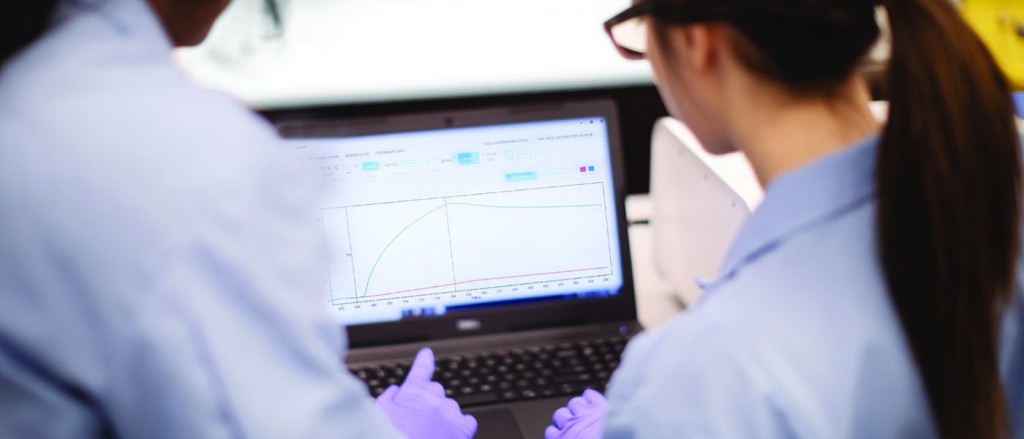Learn about how OpenSPR user Sabrina Apel employs Nicoya’s SPR technology to study protein-protein interactions that regulate muscle function.
Sabrina Apel is a PhD candidate at the University of Massachusetts Lowell. For her doctoral research, Sabrina has leveraged the capabilities of OpenSPR® to explore the binding kinetics of protein-protein interactions related to muscle function and regulation. By providing researchers like Sabrina with innovative SPR instruments, Nicoya delivers on its mission of empowering groundbreaking discoveries that have lasting effects on human health and well-being.
Table of contents
- Protein interactions are key to controlling muscle function
- Sabrina’s Research Journey with OpenSPR
- Biomolecular analysis made easy with OpenSPR
- Conclusion
1. Protein interactions are key to controlling muscle function
Sabrina’s research delves into the biochemical processes that control muscle contraction and function. In particular, her research focuses on titin, the largest known protein and a key structural protein of the sarcomere [1]. Titin contains multiple domains and unstructured regions known to form protein-protein interactions that change its structure and function. Sabrina’s work focuses on characterizing the interaction of the UN2A region of titin with the protein S100A1, a regulatory protein that responds to physiological stimuli by forming interactions in the presence of Ca2+[2]. Understanding the conditions required for this interaction will provide greater insight into how the muscle responds to physiological changes.
Diagram of titin in the muscle. Adapted from [3].
Sabrina’s work on muscle physiology holds promise for understanding critical aspects of muscle function and developing treatments for disorders such as muscular dystrophy [4]. Moreover, her research has broader implications in developing treatments and management strategies for other muscle conditions, such as age-related muscle loss or sarcopenia [5]. As our population ages [6], understanding the molecular mechanisms behind muscle function can greatly improve the quality of life for many individuals.
Owing to its user-friendliness and versatility, OpenSPR is currently used in more than 500 research labs worldwide and has been cited in over 315 publications. This includes research in therapeutic areas ranging from oncology, immunology and infectious disease as well as applications compatible with proteins/peptides, antibodies, nucleic acids, lipids, small molecules (application dependent), adeno-associated viruses (AAV), virus-like particles (VLPs), hormones/cytokines, and crude samples.
2. Sabrina’s Research Journey with OpenSPR
We sat down with Sabrina to learn more about her research, what motivates her, and the pivotal role that OpenSPR plays in her scientific pursuits.
“Tell us a bit about yourself and the research group you work with at the University of Massachusetts Lowell.”
SA: I am pursuing a PhD in Biochemistry in Dr. Matthew Gage’s Research Lab at the University of Massachusetts Lowell. I am committed and passionate about the intricacies of molecular biology and protein chemistry.
Our lab focuses on understanding the relationship between the structure of a protein and its function. Specifically, the main focus of our lab is understanding the function of the titin protein, which regulates passive tension in muscle fibres and has been shown to contribute to active force generation. We seek to stretch our understanding of protein chemistry to improve the human state.

Members of Dr. Matthew Gage’s research lab.
“What motivates you to take on your research and find new answers?”
SA: I am motivated by the opportunity to contribute to knowledge and make meaningful advancements in science, fueling my curiosity and passion for research. I have a desire to take on challenges that allow me to continue seeking new answers. I’m inspired by the potential impact research can have on improving lives and benefitting society.
“Why did you choose OpenSPR for your research project(s)?”
SA: I chose OpenSPR for my research project because of its real-time data and monitoring of biomolecular interactions without the need for labeling. The high sensitivity of the OpenSPR systems allows me to investigate protein-protein interactions at low concentrations, which is critical for muscle research. Protein-protein interactions within the sarcomere may involve weak binding affinities, and quantifying these interactions will help elucidate their functional significance in muscle physiology.
“Where do you see your research project in the future? What will it bring to the science community?”
SA: I see my research project making significant and new contributions to the science community in the future, particularly in the context of muscle physiology and the role of titin. My research could provide valuable insights into the molecular mechanisms underlying muscle contraction, relaxation, and force generation. Discovering the functional significance of titin interactions could also lead to the development of therapeutic targets aimed at restoring muscle function.
3. Biomolecular analysis made easy with OpenSPR
OpenSPR is the world’s first benchtop SPR system, allowing more researchers to access this information rich method for measuring binding interactions. Utilizing localized surface plasmon resonance (LSPR) technology, OpenSPR delivers highly sensitive and repeatable kinetics and affinity data. This innovative nanotechnology maintains the performance of a traditional SPR system while supporting cost-effective research, making owning an SPR system more accessible to every scientist.

Scientists working with OpenSPR in the lab
Why choose OpenSPR?
- Wide range of research applications: Our unique nano-structure sensor surface with LSPR technology enables highly sensitive kinetic data measurement for various molecules including proteins/peptides, antibodies, nucleic acids, lipids and more.
- Time-saving label-free analysis: Unlike traditional detection methods, OpenSPR eliminates the need for labeling molecules, facilitating real-time interaction measurements. This avoids the complexities and costs associated with labeling steps.
- User-friendly design: OpenSPR’s hardware and software is thoughtfully designed to make operation and data generation quick and easy. This winning combination allows for the generation of publication-quality data quickly, at your benchtop.
- Select what best fits your research needs: Choose between OpenSPR, a two-channel solution ideal for new or occasional users, and OpenSPR-XT, a fully automated system for users looking for hands-free operation. If you are looking for even greater throughput and automation, consider Alto, our next-generation digital SPR instrument.
5. Conclusion
Since its release, OpenSPR has become a leading platform for label-free biomolecular analysis, bringing Surface Plasmon Resonance (SPR) technology to benchtops in over 50 countries worldwide. With its versatility, affordability and user-friendly design, OpenSPR empowers researchers like Sabrina to unravel the complexities of biomolecular interactions with ease. As we continue to push the boundaries of scientific research, OpenSPR stands at the forefront of innovation, simplifying research endeavors and advancing the pace of discovery.
Join 600+ researchers worldwide who are shaping the future of science with OpenSPR!
References
- Apel SI. Characterization of binding interaction between S100A1 and titin’s UN2A region. Biophys J. 2023;122(3):464A. doi: 10.1016/j.bpj.2022.11.2487
- Wright NT, Cannon BR, Zimmer DB, Weber DJ. S100A1: Structure, Function, and Therapeutic Potential. Curr Chem Biol. 2009;3(2):138–145. 10.2174/187231309788166460
- Nakanishi N, Tsutsumi R, Hara K, Matsuo M, Sakaue H, Oto J. Urinary titin N-fragment as a biomarker of muscle atrophy, Intensive Care Unit-acquired weakness, and possible application for post-intensive care syndrome. Journal of Clinical Medicine. 2021;10(4):614. doi:10.3390/jcm10040614
- Stroik D, Gregorich ZR, Raza F, Ge Y, Guo W. Titin: Roles in cardiac function and diseases. Frontiers in Physiology. 2024;15. doi:10.3389/fphys.2024.1385821 World Health Organization. Ageing and health.
- Preserve your muscle mass. Harvard Health. February 19, 2016. Accessed June 19, 2024. https://www.health.harvard.edu/staying-healthy/preserve-your-muscle-mass#:~:text=Age%2Drelated%20muscle%20loss%2C%20called,muscle%20mass%20during%20their%20lifetimes.
- World Health Organization. October 1, 2022. Accessed June 19, 2024. https://www.who.int/news-room/fact-sheets/detail/ageing-and-health.


